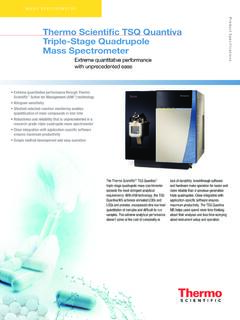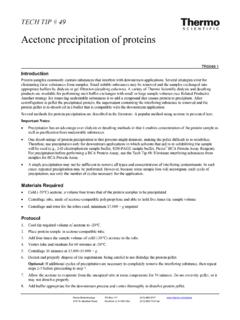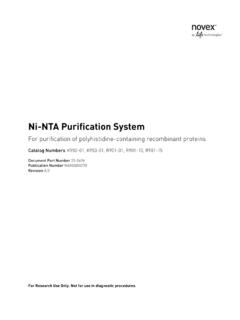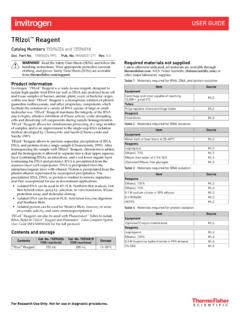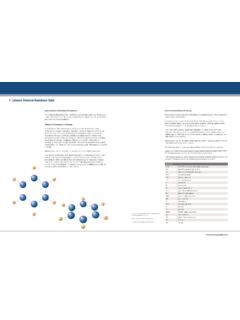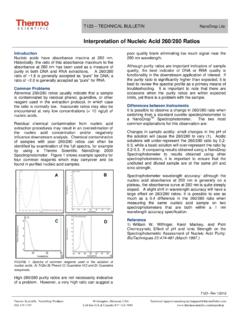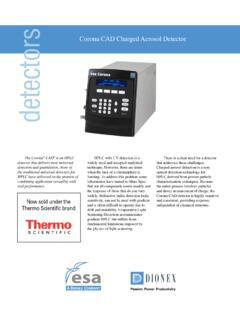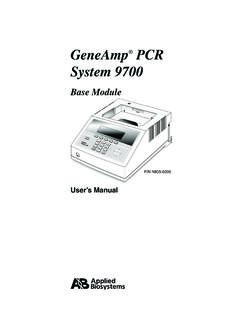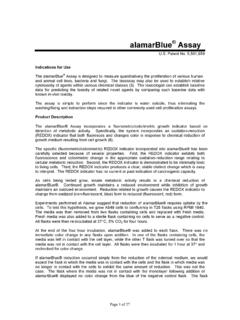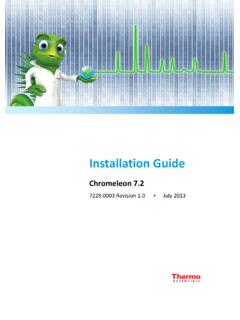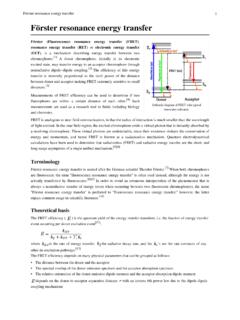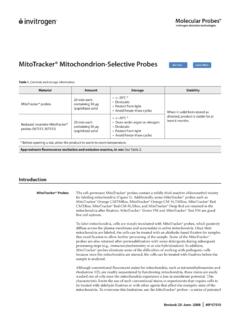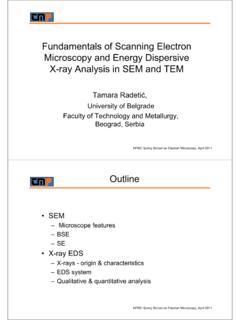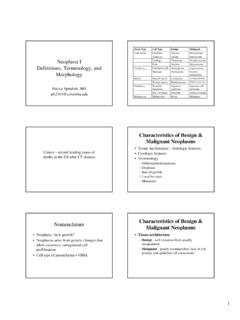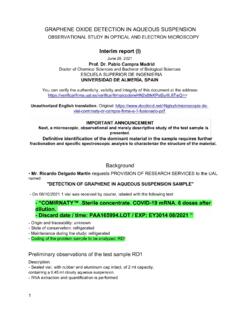Transcription of EdU (5-ethynyl-2’-deoxyuridine)
1 MAN0001955 Revised: 12 July 2010 | MP 10044 EdU (5-ethynyl-2 -deoxyuridine)Catalog nos. A10044, E10187, E10415 IntroductionEdU (5-ethynyl-2 -deoxyuridine) is a novel alternative for BrdU (5-bromo-2 -deoxyuridine) assay to directly measure active DNA synthesis or S-phase synthesis of the cell cycle. EdU is a nucleoside analog of thymidine and is incorporated into DNA during active DNA Detection of EdU is based on a click reaction,1-5 which is a copper (I) catalyzed reaction between an azide and an alkyne. The EdU contains the alkyne which can be reacted with the an azide-containing detection reagent, to form a stable, triazole ring (Figure 1). The advantages of the click reaction with EdU labeling are readily evident while performing the assay. The small size of the detection azide allows the use of mild conditions to access EdU incorporated into the DNA.
2 This is in contrast to BrdU-based assays that require DNA denaturation (typically using HCl, heat, or digestion with DNase) to expose the BrdU for detection with an anti-BrdU antibody (Figure 2). Eliminating the denaturation step allows for a simple, fast protocol producing more reproducible results and measurements which are easily multiplexed with relevant antibody based targets including phospho-histone H3, Ki-67, and cyclin B1 by flow cytometry, fluorescence microscopy , or high-throughput imaging (HCS) (Figures 3 and 4).Table 1. Contents and storage *StabilityEdU (5-ethynyl-2 -deoxyuridine)50 mg (A10044)500 mg (E10187)5 g (E10415) 20 C DesiccateWhen stored as directed, the product is stable for 1 2 yearsFigure 1. Click reaction between EdU and azide-modified dye or | 2 Figure 3. Multiparameter analyses with EdU by flow cytometry.
3 After treating U266 myeloma cells with 10 nM nocodazole for 15 hours, the cells were incubated with 10 M EdU for 1 hour. Cells were harvested and dead cells were labeled with the LIVE/DEAD Fixable Near-IR Dead Cell Stain (Invitrogen Cat. no. L10119) prior to fixation with 4% paraformaldehyde in PBS. Cells were saponin-permeabilized and EdU was detected with the Click-iT EdU Alexa Fluor 488 Flow Cytometry Kit (Invitrogen Cat. no. C35002). Phosphorylated histone H3 and cyclin B1 were labeled using Alexa Fluor 647 rat anti-histone H3 (pS28) and purified mouse anti-Cyclin B1 (GSN-1) complexed with Zenon R-Phycoerythrin Mouse IgG1 Labeling reagent (Invitrogen Cat. no. Z25055), respectively. DNA content was labeled with DAPI (Invitrogen Cat. no. D1306). Acquisition and analysis was performed on a BD LSRII flow cytometer using 355 nm, 488 nm, and 633 nm excitations in 5-color analysis with BD.
4 EdU signal was plotted against DNA content and shows an increase of cells in G2M phase with the nocodazole 2. Detection of the incorporated EdU with Alexa Fluor azide versus incorporated BrdU with an anti-BrdU antibody. The small size of the Alexa Fluor azide eliminates the need to denature the antibodyInaccessiblewithoutdenaturationC lick-iT Alexa Fluor azideAccessibleIncorporated EdUXIncorporated BrdUONHNOBrEdU | 3 Before You BeginPreparing Stock SolutionEdU is readily soluble in DMSO, alcohol, water, or aqueous buffers. For use with in vitro applications, prepare 10 mM EdU stock solution in DMSO or aqueous buffer. Store 10 mM EdU stock solution at 20 C for one year. EdU has a characteristic 288 nm absorption peak which can be used to accurately quantitate stock solutions by absorbance using the extinction coefficient of 12,000 cm-1M-1 in methanol.
5 A 10 mg/mL solution ( mM) when diluted 1/1,000 in methanol gives an absorbance of at 288 nm. Handling and DisposalEdU is a nucleoside analog which can be incorporated into DNA. Handle and dispose of EdU in compliance with all pertaining local regulations. When EdU is dissolved in DMSO, which is known to facilitate the entry of organic molecules into tissue, use additional precautions appropriate for the hazards posed by such ToxicityPharmacotoxicity data for EdU is not known. Potential toxicity effects can be reduced by reducing the amount of EdU. Studies of tumorigenicity and cytotoxicity in Zebra Finch and Taeniopygia guttata, showed no abnormal results in a variety of tissues and appeared to be well tolerated. In these studies, the dosage regiment was the same as used for BrdU labeling. Figure 4. Proliferating cells in rat ileum.
6 Rats were treated with a 2 hour pulse of EdU administered (160 g/g body weight). A 5 m thick paraffin embedded tissue was deparaffinized with standard xylene based protocol. Proliferating cells were detected with the Click-iT EdU Alexa Fluor 594 Imaging Kit (Cat. no. C10339). Nuclei were stained with the blue-fluorescent counterstain Hoechst 33342 (Cat. no. H1399).EdU | 4 Experimental ProtocolsEdU LabelingIn initial experiments, we recommend testing a range of EdU concentrations to determine the optimal concentration. If currently using a BrdU-based assay, a similar concentration and duration to BrdU is a good starting concentration for EdU. Lower amounts of EdU can be used to achieve equivalent brightness of labeling as BrdU. The optimal concentration may vary depending upon the duration of the pulse, with lower concentrations recommended for longer incubations.
7 General recommendations are listed below. Details on using EdU, including references, cell images, and data are available at Cultured cells Acceptable EdU incorporation has been observed with cultured cells including mammalian and plant labeled with 10 M EdU for 3 hours. Whole animal Acceptable EdU incorporation has been observed following injection or media incubation (Table 2).Table 2. Using EdU in animal *Nematode (C. elegans)Dorsett M, Westlund B, Schedl T (2009) Genetics 183: 233 247 Flatworm (marine)BioProbes 61 CricketBando T, Mito T, Maeda Y et al. (2009) Development 136: 2235 2245 MouseSalic, A (2008) Proc Natl Acad Sci USA 105: 2415 2420 Bonaguidi MA, Peng CY, McGuire T et al. (2008) J Neurosci 28: 9194 9204 Kharas MG, Janes MR, Scarfone VM et al. (2008) J Clin Ivest 118: 3038 3050 Zeng C et al.
8 (2010) Brain Res 1319: 21 32 RatScientific poster, ASCB 2007 Zebrafish larvaBioProbes 57 Zebra finchScientific poster ASCB 2007 Human-derived stem cellsMcCord AM, Jamal M. Williams ES et al. (2009) Clin Cancer Res 15: 5145 5153 Momcilovic O, Choi S, Varum S et al. (2009) Stem Cells 27: 1822 1835*Visit for links to PubMed entries, scientific poster, or detailed Pulse LabelingFollow these guidelines to perform dual labeling of cultured cells and tissue by combining EdU with BrdU labeling (Figure 5): Use EdU for the first pulse and BrdU for the second pulse. Removal of EdU from the media is not required in cultured cells when BrdU is added as the second label. Addition of BrdU to culture media containing EdU results in preferential incorporation of BrdU into the DNA with the exclusion of EdU, while simultaneous addition of EdU with equimolar or half equimolar BrdU to the media results in only BrdU incorporation.
9 This simplifies the dual labeling protocol by eliminating the wash step normally required to re-move the first label from the culture media prior to addition of the second label. Process cells or tissues after dual pulse labeling using a proven BrdU protocol. Combine the click detection protocol with the BrdU protocol. For cultured cells, the BrdU protocol usually requires an alcohol fixation followed by some method of DNA denaturation. After the DNA denaturation/neutralization step in the BrdU protocol, cells are first click labeled for the detection of EdU followed by an antibody labeling protocol for the detection of BrdU. Select a BrdU antibody which does not have cross-reactivity to EdU. Many BrdU antibodies have been shown to have some amount of cross-reactivity with incorporated | 5 EdU detectionIncorporated EdU can be detected with a Click-iT EdU Kit (Table 3) or with an available dye- or hapten-containing azide (Table 4).
10 Two of the fluorescent dyes, Alexa Fluor 488 and Oregon Green 488 can be used as fluorescent dyes or haptens with an anti-dye 5. Dual pulse labeling with EdU and BrdU. TF-1 erythroblast cells were pulsed with 20 M EdU for 1 hour followed by 10 M BrdU for 1 hour. The cells were fixed in ethanol, and an acid denaturation method was used before labeling with anti-BrdU (Clone MoBU-1)-Alexa Fluor 488 conjugate (Cat. no. B35139) and Click-iT EdU-Alexa Fluor 647 azide (Cat. no. A10202). Data were collected with a BD LSR II flow cytometer using 488 nm excitation with a 530/30 bandpass filter, and 633 nm excitation with a 660/20 bandpass filter. Cells colored blue are negative for both EdU and BrdU (lower left quadrant); cells colored dark green are positive for both EdU and BrdU (upper right quadrant); cells colored red are positive for EdU but negative for BrdU (lower right quadrant); cells colored light green are negative for EdU but positive for BrdU (upper right quadrant).
